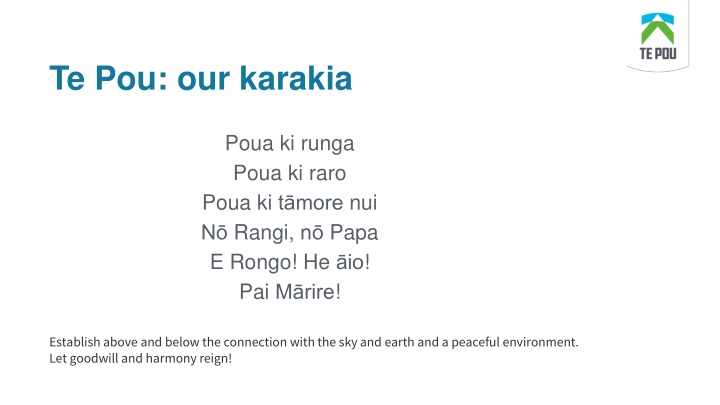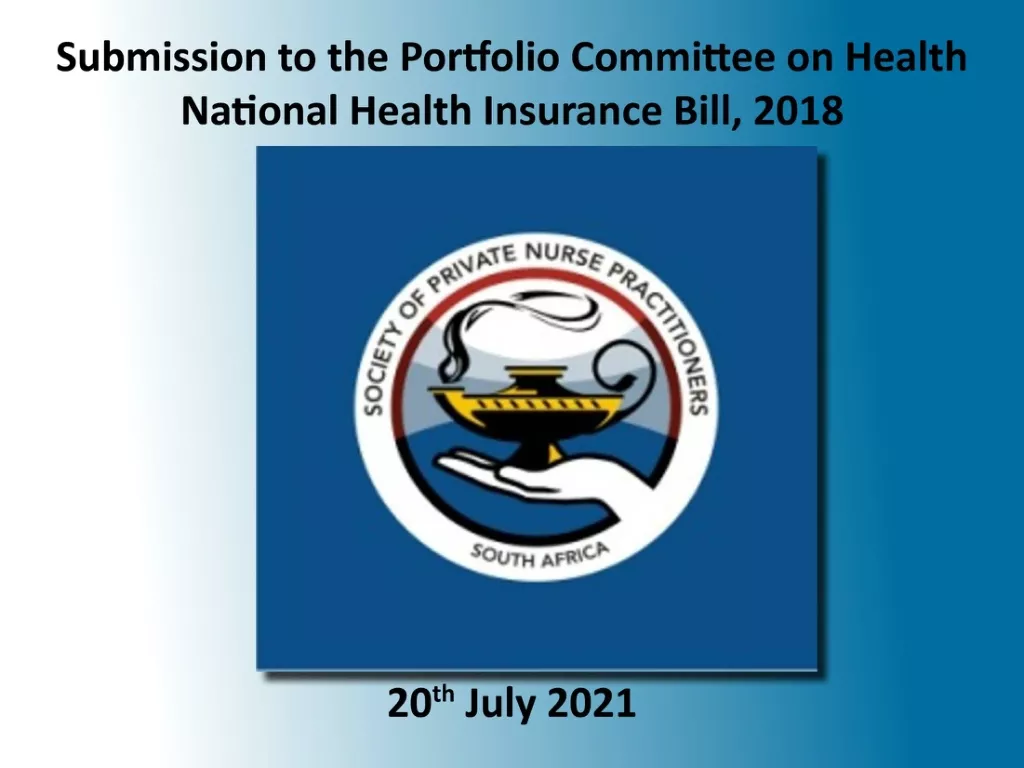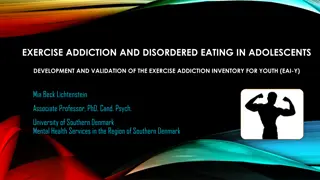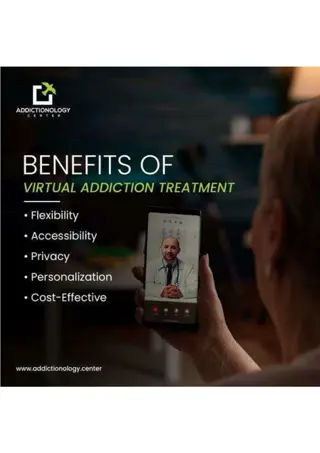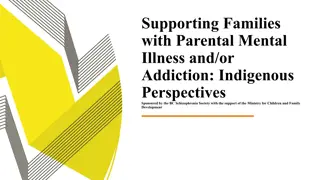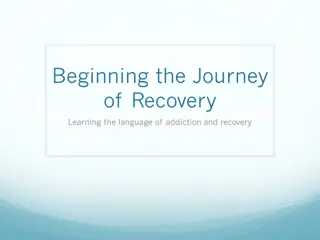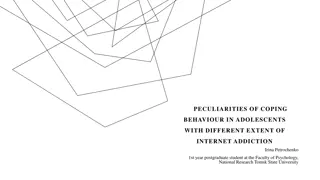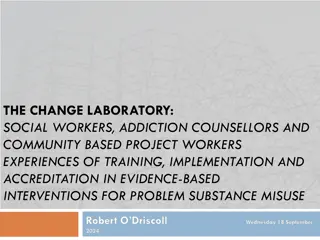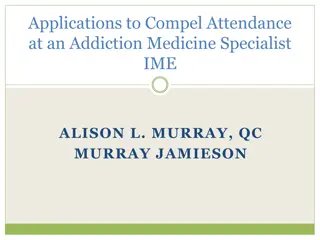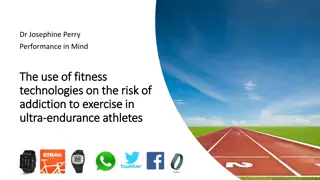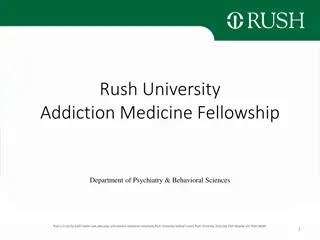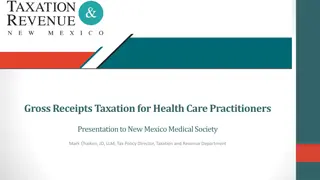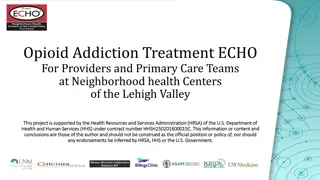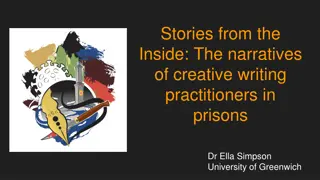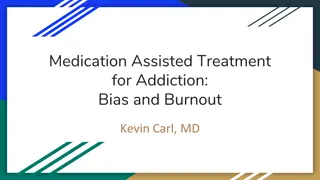ADOM Training for Addiction Practitioners
Training program for addiction practitioners on Alcohol and Drug Outcome Measure (ADOM), providing information on collection and use of ADOM, Information Collection Protocol (ICP), and the ADOM Guide to enhance reporting and practice consistency. The program consists of two modules covering health outcomes, ADOM implementation, use of outcomes information, and training the trainers for effective utilization. Participants engage in discussions, polls, and breakout sessions to deepen understanding and application of ADOM principles.
Download Presentation

Please find below an Image/Link to download the presentation.
The content on the website is provided AS IS for your information and personal use only. It may not be sold, licensed, or shared on other websites without obtaining consent from the author.If you encounter any issues during the download, it is possible that the publisher has removed the file from their server.
You are allowed to download the files provided on this website for personal or commercial use, subject to the condition that they are used lawfully. All files are the property of their respective owners.
The content on the website is provided AS IS for your information and personal use only. It may not be sold, licensed, or shared on other websites without obtaining consent from the author.
E N D
Presentation Transcript
Te Pou: our karakia Poua ki runga Poua ki raro Poua ki t more nui N Rangi, n Papa E Rongo! He io! Pai M rire! Establish above and below the connection with the sky and earth and a peaceful environment. Let goodwill and harmony reign!
Alcohol and Drug Outcome Measure (ADOM) training For training addiction practitioners in the reporting and use of ADOM
Objectives of this ADOM training As an ADOM Trainer, you will be: provided with information and resources to support consistent collection and use able to use the ADOM effectively and in accordance with the ADOM Information Collection Protocol (ICP) familiar with and use the ADOM Guide for Addiction practitioners as a resource able to impart this information back to your colleagues or service.
Module 1 There are 2 modules to this training, Module one covers section 1 and 2: Section 1: Background to health outcomes and outcome tools Section 2: Implementing the ADOM WHAT about ADOM WHO? - are eligible services and t ngata whai ora HOW & WHEN - to collect and use the ADOM (ICP)
Module 2 Section 3: Using outcomes information Section 4: Training the trainers to train.
Poll Poll on confidence in training people with ADOM
Section 1 Background to health outcomes
Pre reading Slides were sent to you prior to course, to be read before training. Any questions on these?
Breakout Groups Discussion: What are the differences between inputs, outputs and outcomes Take 10 mins. Very quickly introduce yourselves and then discuss. You will be automatically assigned a group and brought back to the main group
Outcome measures (OM) Outcome definition: an outcome is a change in health, wellbeing and circumstances over time. (Te Pou 2012)
An outcome measure has a: standard set of statements or questions defined points to measure change over a period of time standardised rating system for each statement or question The set of rules for rating the measure is called an Information Collection Protocol (ICP).
Therefore each time the outcome measure is used: the same information is collected in the same way so information collected can compare change over time ( comparing apples with apples ).
New Zealand outcome measures domains and raters Outcome measure identified Outcome domain type Rater The Health of the Nation Outcome scales (HoNOS) suite of outcome measures mandated form 2004 Clinician rated and shared with the t ngata whai ora Symptom severity The Alcohol and Drug Outcome Measure (ADOM) mandated from 1 July 2015 Alcohol and other drug use; Lifestyle, wellbeing and recovery t ngata whai ora rated, practitioner facilitated Hua Oranga M ori mental health outcomes. Voluntary use t ngata whai ora, Wh nau and clinician rated. M ori health T ku Reo T ku Mauri Ora t ngata whai ora outcomes measure for Aotearoa, New Zealand. Voluntary use T ngata whai ora recovery t ngata whai ora rated
Section 2: Implementing the ADOM
Breakout groups Discussion: What does implementing ADOM mean to you? 5 mins to discuss. You won t need to share or feedback to main group
ADOM Guide for addiction practitioners Newest version is always on Te Pou website. Core document for national implementation of ADOM. includes: information about ADOM eligibility criteria information collection protocol (ICP) clinical pathways and collection occasions facilitating ADOM collection Referred to in the document as the ADOM Guide or the Guide .
What is ADOM? ADOM was developed in 2009 (current version 2013) extensive consultation and validation process high interest and demand for an outcomes measure for and from addiction sector ADOM implementation project ADOM finalised and ADOM Feedback Wheel developed Voluntary implementation 2014, mandatory rollout 2015.
Design and intent Refer to: Section 1 - About the ADOM in ADOM Guide for use in adult community-based outpatient addiction services or programmes collaborative process practitioner and t ngata whai ora provides a summary of t ngata whai ora treatment journey demonstrates change over time NOT a clinical tool for screening, assessment or review.
Breakout groups Discussion: What did you take from the video? 5 mins to discuss. You won t need to share with main group
Sections Heading Demographics and identifiers these help identify the context for the data collected Section 1 Q1 Q9 substance use Q10 Q11 - injecting use and/or sharing needles Section 2 Q12 Q17 lifestyle and wellbeing, including health, accommodation, daily activities Q18 criminal or illegal activity Section 3 Q19 and Q20 recovery and goal progression.
Question types Refer: Section 4.5 - Facilitating ADOM collection in ADOM Guide frequency of use Q1 to 7 (excl. Q2), Q10, Q12 to 18 quantity used Q2 and Q 8 prioritise substance(s) of concern Q9 YES and NO Q 11 rating scales Q12 to 18 rating scale - Q19 and 20.
WHO? ADOM eligibility exercise Refer to Section 3 - ADOM eligibility criteria in ADOM Guide Which services are eligible to collect ADOM? Which t ngata whai ora are eligible for ADOM collection?
HOW is ADOM collected? Refer to: Section - Essential training for ADOM clinicians in ADOM Guide Information Collection Protocol (ICP) clinical pathways and collection occasions practitioner role
Information Collection Protocol (ICP) Refer: Section 4.1 Information Collection Protocol in ADOM Guide Following the ICP ensures we collect good quality data from t ngata whai ora who have provided this information. This means practitioners, teams, and services are all collecting the same data and information - when it is used we know we are comparing apples with apples .
ADOM collection occasions ADOM is collected during an episode of care at the following treatment stages: Treatment start (Assessment) ADOM Review ADOM Treatment end (Discharge) ADOM Your ADOM data collection and reporting system may provide a reminder when due.
Clinical pathway and ADOM collection occasions Refer: Section 4.2 in the ADOM Guide for Addiction Clinicians on page 15
Treatment start - ADOM Refer: Section 4.3 - Collection occasions in ADOM Guide Treatment start ADOM Reason for collection/collection date New t ngata whai ora entering service assessment completed. The intention is ongoing treatment with the service. treatment start - New complete ADOM within 2 weeks of treatment start. New t ngata whai ora entering service (referral from other addiction service). Assessment completed. The intention is ongoing treatment with the service. treatment start other AOD service complete ADOM within 2 weeks of treatment start. New t ngata whai ora entering service - assessment indicates referral on to more appropriate service (e.g. residential, detox or mental health), or is not appropriate to service. assessment only complete ADOM within 2 weeks of assessment.
Treatment reviews - ADOM Refer: Section 4.3 - Collection occasions in ADOM Guide Review ADOM Reason for collection/collection date at 6 weeks from the treatment start ADOM. treatment review 6 weeks complete ADOM 2 weeks either side of 6 week review due date. at 12 week intervals, from the last review ADOM . treatment review 12 weeks/3 months complete ADOM 2 weeks either side of 12 week review due date.
Treatment end/discharge - ADOM Refer: Section 4.3 - Collection occasions in ADOM Guide Treatment end ADOM At planned discharge from current episode of care. Reason for collection/collection date treatment end routine complete ADOM within 1 week of treatment end date. t ngata whai ora does not attend planned appointments. treatment end DNA complete ADOM, administrative data only, within one week of treatment end. Other AOD service. treatment end other AOD service complete ADOM within 1 week of treatment end. Other for example t ngata whai ora deceased or other reason that does not fit into categories above. treatment end other complete ADOM, administrative data only, within one week of treatment end.
Breakout Groups Discussion: What are the collection occasions for ADOM 10 mins to discuss. Choose someone in group who can feedback your discussion to main group
Focus of care Identifies the main focus of care provided over the period of care ie 6 or 12 weeks: engagement, screening and assessment active treatment continuing care. What do these terms mean in relation to ADOM?
The practitioner role Refer to: Section 4.5 The clinicians role in ADOM Guide collaborative practitioner introduces and facilitates ADOM collection process motivational approach - positive engagement, listening and non- judgmental feedback ensure a safe confidential environment integrate in to good clinical practice.
Recap Module 1 Background to outcomes Implementing ADOM
Section 3: How can outcomes information be useful?
Successful implementation reminder For data to be useful it needs to become part of every day practice what we do around here This requires: strong leadership planning and phasing of implementation user friendly IT structure and systems training and education quality improvement outcomes coordination - local, regional, national.
Value at different levels T ngata whai ora level Service level National utility
Individual (tngata whai ora and practitioner) utility Informs and shape treatment. There is evidence that feedback improves recovery for clients (Michael Lambert, USA) Assist t ngata whai ora to view progress with their recovery And areas where progress has not occurred or intervention can be offered Service users want to know how they are doing in a more systematic way (AMHOCN) Provides practitioners with a means for reviewing treatment planning and goals with t ngata whai ora.
ADOM outcomes data provides a summary of change during treatment journey for t ngata whai ora covers many important aspects of the t ngata whai ora experience and treatment eg ADOM provide information about: alcohol and drug use individual s lifestyle and wellbeing Individual view of progress and satisfaction.
Making data useful? data collected must be easy to use easy to see what s happening offer benefit to all involved. ADOM feedback wheel provides a means of sharing a visual representation of the service users progress with the t ngata whai ora.
Breakout Group Discussion: What did you take from the video? 5 mins discussion. No expectation on sharing with main group.
How can outcomes information be useful? Ref: Malcolm Stewart PhD P.G. Dip. ClinPsych, Thrive Psychology Limited. National Level Grouped information to understand service users, understand outcomes, and identify best practice Service Level Both of these Team Level Interaction Level t ngata whai ora and practitioner Promoting conversation about individual s goals and outcomes
Number valid ADOM collection by reason for collection and organisation type, July 2020 to June 2021 From Report 11: Source: Ministry of Health, PRIMHD extract 1 November 2021, analysed and formatted by Te Pou.
Distribution of substance of main concern at ADOM treatment start collections, by age group, July 2020 to June 2021 From Report 11: Source: Ministry of Health, PRIMHD extract 1 November 2021, analysed and formatted by Te Pou.
Distribution in lifestyle and wellbeing for ADOM treatment start and end for matched pairs, July 2020 to June 2021 From Report 11: Source: Ministry of Health, PRIMHD extract 1 November 2021, analysed and formatted by Te Pou.
